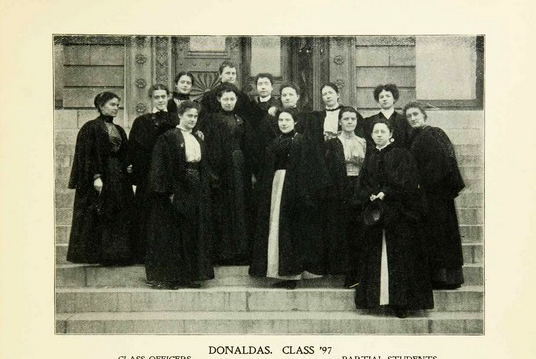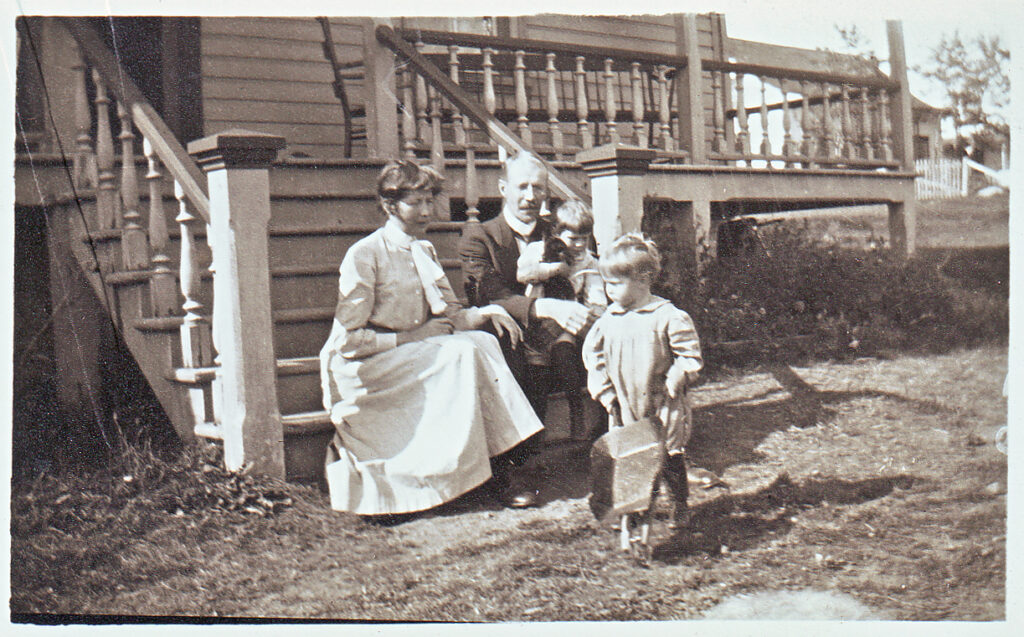At the turn of the century, Annie Louise Smith belonged to an exclusive group of young women known as the Donaldas. They were the first women to graduate from McGill University in Montreal. The university began accepting female students in 1884 and Louise and 13 other women made up the Donalda class of 1897.

The nickname Donalda was a reference to Donald A. Smith, a Scottish-born businessman who spent many years with the Hudson Bay Company and played an important role in the construction of the Canadian Pacific Railway. He provided a substantial endowment to the university on condition that the standard of education for women be the same as that for men.
As far as I know, Louise was not related to Donald Smith. Her father, John Murray Smith, was a bank manager who had come to Canada from Scotland as a child. Louise was lucky because, according to a family story, her father believed in education for women, however, he died in 1894 and did not see her graduate.
Louise was born 11 August, 1875 in Peterborough, Ontario, where her father was manager of the Bank of Toronto. Her mother was Jane Mulholland, the daughter of a Montreal hardware merchant. Louise was one of six children: she had an older brother, Henry (1873-1891), and four younger siblings: May (1877-1953), Fred (1879-1956, my future grandfather), Ella (1881-1964) and Mabel (1884-1966). None of her siblings followed Louise to university.
The family left Peterborough in 1877 when Louise’s father was transferred to Montreal. They lived downtown for the first few years, and, in 1881, they moved into a stone house in a newly developed part of the city on McGregor Avenue (now Docteur Penfield Avenue), on the slope of Mount Royal.
Young women of Louise’s background were not expected to work, even if they had a degree; they were supposed to get married and let their husbands support them. It took Louise several years, however, to find the right man. In 1906, she married Frederic Samuel Macfarlane (1871-1918), who ran a retail lumber business with his father. Their first child, Anne, arrived two years later. In the early years of their marriage, Louise and Fred lived with his parents on Selkirk Avenue, a tiny street just down the hill from the house where Louise had grown up.

Montreal was a growing city and the lumber business did well. Around 1912, Fred and his father opened a west-end branch of the store and the family moved to a larger house on Sydenham Avenue in Westmount. The house was soon full as Louise and Fred had four children: Anne (b. 1908), Isobel (b.1909), Robert (b.1912) and Alice (b.1914).

In 1916, father-in-law Robert Macfarlane died. Two years later, Fred died. Suddenly, Louise was a widow with four young children to raise and a family business with no leadership. She arranged for people to run the store, but they did not have the Macfarlanes’ knowledge of the lumber business, and it soon failed. Fortunately, she had enough money to remain in the house on Sydenham and to send two of her own children to university.
Louise often visited her mother and three unmarried sisters, who still lived together in the house on McGregor, and they all celebrated Christmas and birthdays together. Her brother, Fred Murray Smith, and his wife also lived nearby.
When daughter Anne got married in August 1934, Louise was described in the marriage register as a librarian. No doubt the job didn’t pay much, but she probably found it satisfying. However, Louise was now living on borrowed time.
In April 1935, her second daughter, Isobel, got married in the family home on Sydenham. This time when Louise signed as a witness, her hand was shaky. She had cancer. In August, Anne gave birth to the first of Louise’s ten grandchildren. Louise died on Sept. 18, 1935, age 60, and is buried with her husband in Mount Royal Cemetery.
Photo Credits: Donaldas class of 97, Old McGill 98, p. 45, http://yearbooks.mcgill.ca/viewbook.php?campus=downtown&book_id=1898#page/56/mode/2up. Courtesy Benny Beattie. Lovell’s Montreal Directory (1842-1992), 1912-1913, p. 1536, bibnum2.banq.ca/bna/lovell/index.html
Notes
See the online article about women at McGill: Blazing Trails: McGill’s Women, https://www.mcgill.ca/about/history/features/mcgill-women
This story relies to a great extent on family stories. I used Lovell’s Directory (bibnum2.banq.ca/bna/lovell/) to track the family’s movements in Montreal, and Ancestry.ca, familysearch.org and cemetery records to check birth, marriage and death dates. I have not found the marriage record; not all Presbyterian records are included in the Drouin Collection of Quebec Vital and Church Records. Nor did I find them in the 1911 census, but that could be an indexing issue; Lovell’s told me where they lived.



